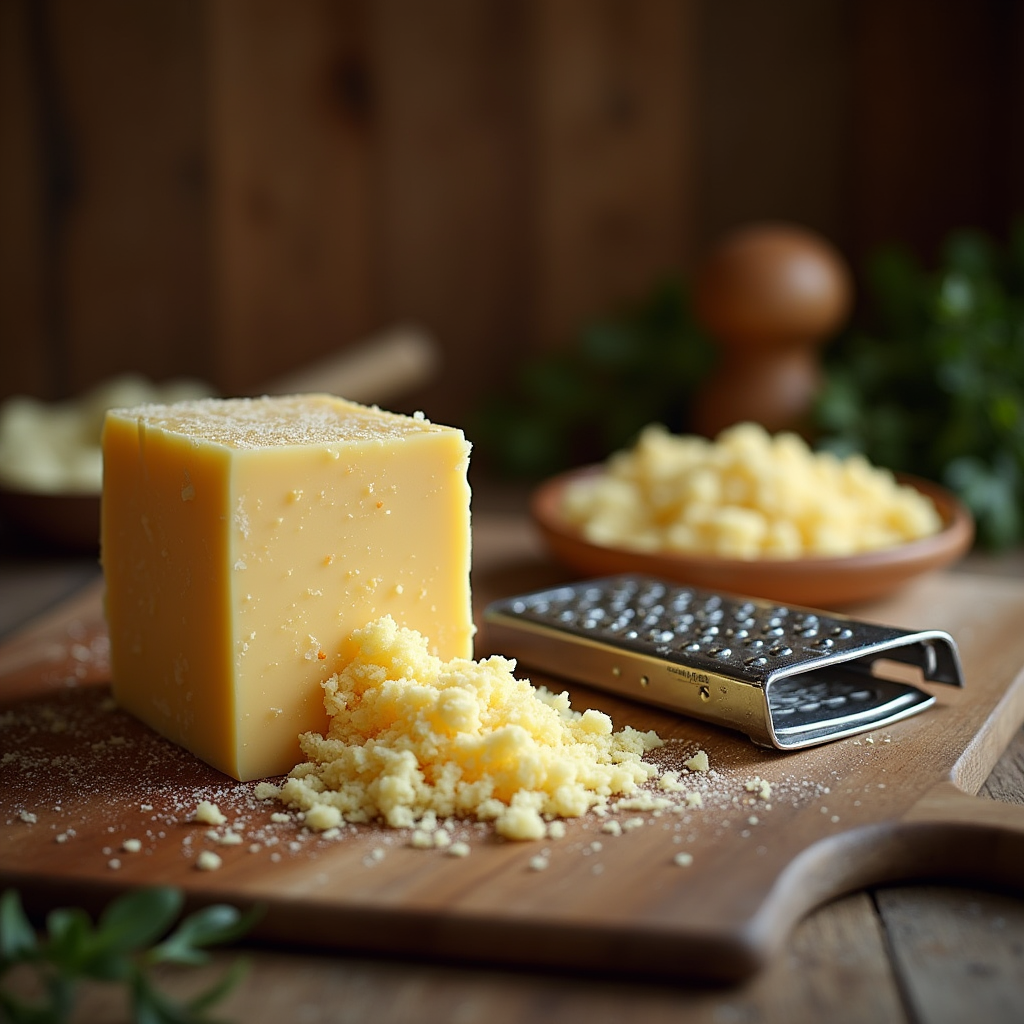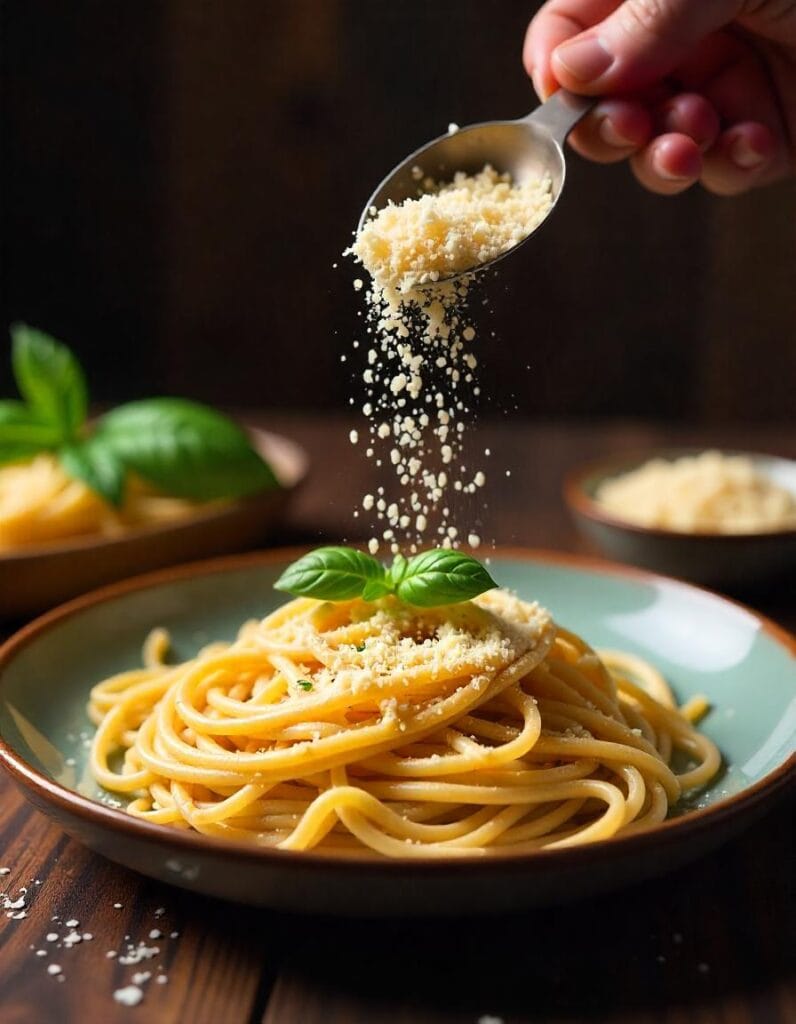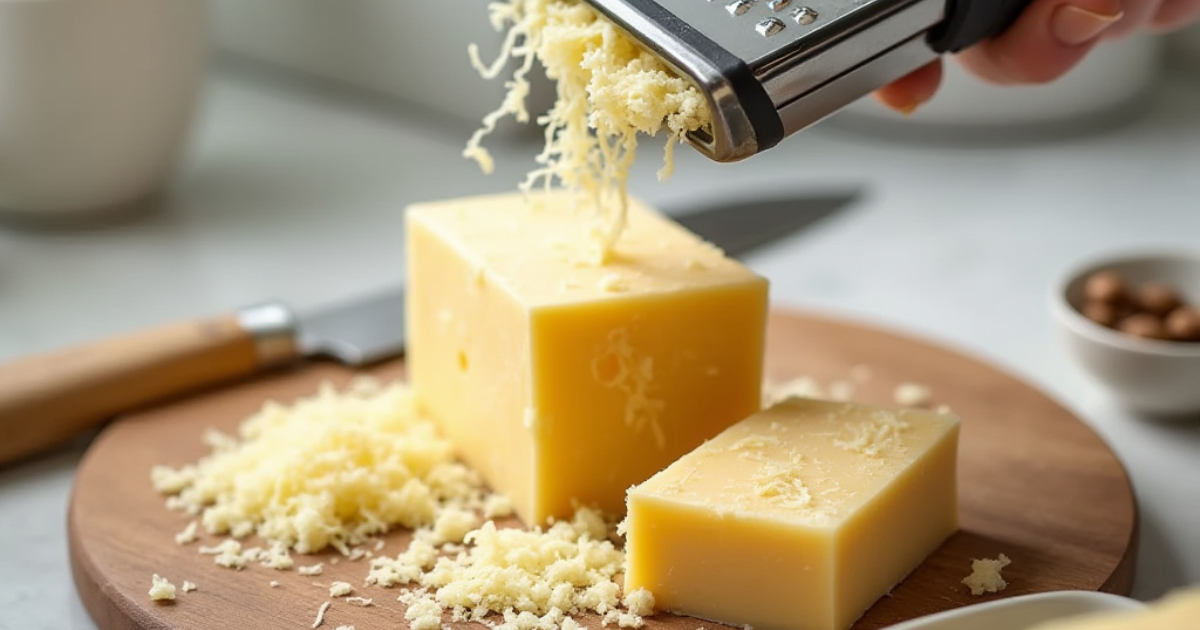Introduction
Have you ever wondered what makes your favorite pasta, soups, or salads taste so irresistible? The answer is often in the humble yet extraordinary grated Parmesan cheese. Freshly grated Parmesan isn’t just a topping—it’s a game-changer, adding a burst of savory flavor and a touch of elegance to any dish. Unlike pre-packaged options, grating your own Parmesan guarantees unmatched freshness and authenticity.
In this recipe, I’ll show you how easy it is to prepare your own grated Parmesan at home, using simple tools and techniques. Whether you’re crafting a comforting bowl of pasta or elevating roasted vegetables, this guide will help you unlock the full potential of this classic cheese. Ready to transform your dishes? Let’s dive in!
Key Benefits
Grating your own grated Parmesan cheese at home offers so much more than just a flavor boost—it’s a culinary upgrade you’ll love. Here’s why:
- Unparalleled Freshness: Freshly grated Parmesan cheese has a richer, more vibrant flavor compared to pre-packaged options, enhancing the taste of any dish.
- Versatility: From pasta and risotto to soups and roasted vegetables, Parmesan cheese complements almost everything on your menu.
- Cost-Effectiveness: Buying a whole block of Parmesan and grating it as needed is not only economical but also reduces waste.
- Customizable Texture: Whether you prefer fine shavings for a delicate finish or coarser grates for a bold presence, grating at home gives you full control.
- Healthy and Authentic: Fresh Parmesan is free from additives or anti-caking agents found in some pre-grated products, making it a cleaner and more wholesome choice.
With these benefits in mind, it’s clear that freshly grated Parmesan isn’t just an ingredient—it’s the secret to elevating your cooking. Ready to get started? Let’s move on to the essentials!
Ingredients
To make grated Parmesan cheese at home, you’ll need just a couple of essentials. Here’s what to gather:
- Fresh Parmesan Cheese Block
Look for a high-quality block of Parmesan, such as Parmigiano-Reggiano, for the best flavor. Avoid pre-grated options as they often include preservatives that can affect taste and texture. - Grating Tool of Your Choice
Choose a grater based on your needs:- A microplane grater for fine, fluffy shreds perfect for melting or garnishing.
- A box grater for medium to coarse grates, ideal for adding texture to baked dishes.
- A rotary grater for quick and easy grating, especially when serving a crowd.
- Cutting Board and Knife (Optional)
If your Parmesan block is large, a sharp knife can help portion it into manageable pieces before grating.
That’s it—just a few simple tools and a high-quality cheese block, and you’re ready to elevate your cooking with freshly grated Parmesan. Up next: how to grate it like a pro!
Instructions
Grating Parmesan cheese at home is easier than you might think. Follow these simple steps to achieve perfectly grated cheese every time:

- Prepare Your Tools
- Start with a clean grater to ensure smooth and safe grating.
- If your Parmesan block is large, use a sharp knife to cut it into smaller, manageable pieces.
- Select Your Grating Method
- For fine grating, use a microplane. Gently press the Parmesan block against the grater and move it back and forth in a steady motion.
- If you prefer medium to coarse grates, a box grater works best. Use the side with the desired hole size and grate with even pressure.
- For convenience, try a rotary grater—simply load a piece of Parmesan inside, turn the handle, and watch the magic happen!
- Grate in Batches
- Grate only as much as you need to keep the cheese fresh and prevent waste.
- If you plan to store grated cheese, place it in an airtight container and refrigerate for up to a week.
- Handle with Care
- Always watch your fingers as you grate to avoid accidents.
- Use the last bit of the cheese block to flavor soups or sauces—it’s too precious to waste!
With these straightforward steps, you’ll have freshly grated Parmesan ready to enhance any dish. Whether you’re garnishing pasta or adding a cheesy kick to roasted veggies, you’ve now mastered an essential kitchen skill!
Pro Tips and Variations
To make the most of your grated Parmesan cheese, here are some expert tips and creative variations to try:

Pro Tips for Success
- Invest in Quality Parmesan: Authentic Parmigiano-Reggiano offers the best flavor. Check the rind for the official stamp to ensure it’s the real deal.
- Keep it Cold: Parmesan is easier to grate when chilled. If it’s too soft, pop it in the fridge for 10–15 minutes before grating.
- Maximize Flavor: Use the rind! Add it to soups or stews for an extra depth of cheesy flavor—just remove it before serving.
- Prevent Waste: Save leftover grated Parmesan by freezing it in small, portioned bags. This keeps it fresh and ready for quick use.
Creative Variations
- Herb-Infused Parmesan: Mix freshly grated Parmesan with dried herbs like basil, oregano, or rosemary for a custom flavor boost.
- Spicy Parmesan Sprinkle: Add a pinch of red pepper flakes or smoked paprika to grated Parmesan for a zesty kick—perfect for pasta or popcorn.
- Vegan Option: Use plant-based Parmesan substitutes made from nuts or nutritional yeast for a similar savory flavor.
- Custom Textures: Experiment with different grater types to achieve fine shavings for garnishes or coarse chunks for casseroles.
With these tips and variations, your grated Parmesan will go from a simple topping to a true flavor enhancer in any dish. The possibilities are endless—have fun experimenting!
Serving Suggestions
Freshly grated Parmesan cheese is more than just a garnish—it’s the ultimate finishing touch that takes your dishes to the next level. Here are some delicious ways to use it:
Classic Pairings
- Pasta Perfection: Sprinkle freshly grated Parmesan over spaghetti, fettuccine Alfredo, or baked ziti for a creamy, savory boost.
- Soups and Stews: Add a generous handful to minestrone, tomato bisque, or chicken noodle soup to enhance the flavor.
- Salad Topping: Use Parmesan shavings to elevate Caesar salads or mixed greens with a nutty, tangy flair.
Creative Ideas
- Veggie Enhancer: Sprinkle Parmesan over roasted broccoli, cauliflower, or asparagus for a cheesy twist.
- Homemade Chips: Top potato or kale chips with grated Parmesan cheese and bake until crispy and golden.
- Snack Time: Mix Parmesan with popcorn for a savory, addictive snack during movie nights.
Elevate Your Baking
- Cheesy Crusts: Blend Parmesan into bread dough or sprinkle it over pizza crusts for extra flavor.
- Casserole Magic: Add grated Parmesan to casseroles like lasagna or scalloped potatoes for a rich, cheesy layer.
Whether you’re sticking to the classics or experimenting with creative twists, freshly grated Parmesan cheese is your secret weapon for transforming everyday meals into extraordinary culinary experiences. Now, it’s time to savor the results of your hard work!
Conclusion

Grated Parmesan cheese at home isn’t just a simple kitchen task—it’s a rewarding way to elevate your cooking. By choosing fresh, high-quality Parmesan and mastering easy grating techniques, you unlock a world of rich, savory flavor that enhances every dish it touches.
From sprinkling over creamy pasta to using it as a flavorful topping for salads or soups, freshly grated Parmesan cheese is the secret ingredient that turns ordinary meals into memorable culinary creations. Plus, it’s cost-effective, customizable, and free from unnecessary additives, making it a win for your taste buds and your kitchen.
So, whether you’re an experienced home cook or just starting your culinary journey, this recipe equips you with everything you need to enjoy the authentic taste of grated Parmesan cheese. Now, grab your grater, a block of Parmesan, and get ready to add that perfect cheesy touch to your next meal!
FAQs
1. Can I use pre-grated Parmesan instead of grating it myself?
While pre-grated Parmesan is convenient, it often contains additives that can impact the flavor and texture. Grating your own Parmesan ensures maximum freshness and a more authentic taste.
2. What’s the best way to store grated Parmesan?
Store grated Parmesan in an airtight container in the refrigerator. For longer storage, freeze it in small portions. This keeps it fresh and ready for use without losing its flavor.
3. Can I use a blender or food processor to grate Parmesan?
Yes! If you need to grate a large quantity of Parmesan, a blender or food processor can save time. Simply cut the cheese into chunks, pulse until finely grated, and store as needed.
4. How can I tell if my Parmesan is authentic?
Look for the “Parmigiano-Reggiano” stamp on the rind. Authentic Parmesan cheese has a nutty, slightly sharp flavor that’s hard to replicate. Avoid imitations labeled simply as “Parmesan.”
5. What can I do with leftover Parmesan rinds?
Don’t toss them! Parmesan rinds are packed with flavor. Add them to soups, broths, or stews for an extra depth of cheesy goodness. Just remove the rind before serving.
6. Is there a dairy-free alternative to Parmesan?
Yes! Nutritional yeast or plant-based Parmesan substitutes made from cashews, almonds, or sunflower seeds are excellent dairy-free options with a similar savory flavor.
7. How do I choose the right grater for my needs?
A micro plane is perfect for fine grating, a box grater works well for medium or coarse textures, and a rotary grater is ideal for quick, uniform results. Select the grater that best matches the dish you’re preparing.
8. Can I use grated Parmesan cheese in baking?
Absolutely! Parmesan adds a savory, nutty flavor to baked goods like bread, muffins, or savory pies. Mix it into doughs, sprinkle it on top, or incorporate it into fillings for a unique twist.
9. Why is my Parmesan crumbling when I try to grate it?
Parmesan that’s too dry may crumble. To prevent this, store the block properly in a sealed container or wrap it tightly in plastic wrap in the fridge. Slightly chilled Parmesan is easier to grate.
10. What dishes can I elevate with grated Parmesan?
The options are endless! Sprinkle it over pasta, pizza, risotto, roasted veggies, soups, or even popcorn. Grated Parmesan cheese is a versatile ingredient that enhances both simple meals and gourmet creations.
Feel free to ask more questions as you perfect your Parmesan game—there’s always something new to learn in the kitchen!

